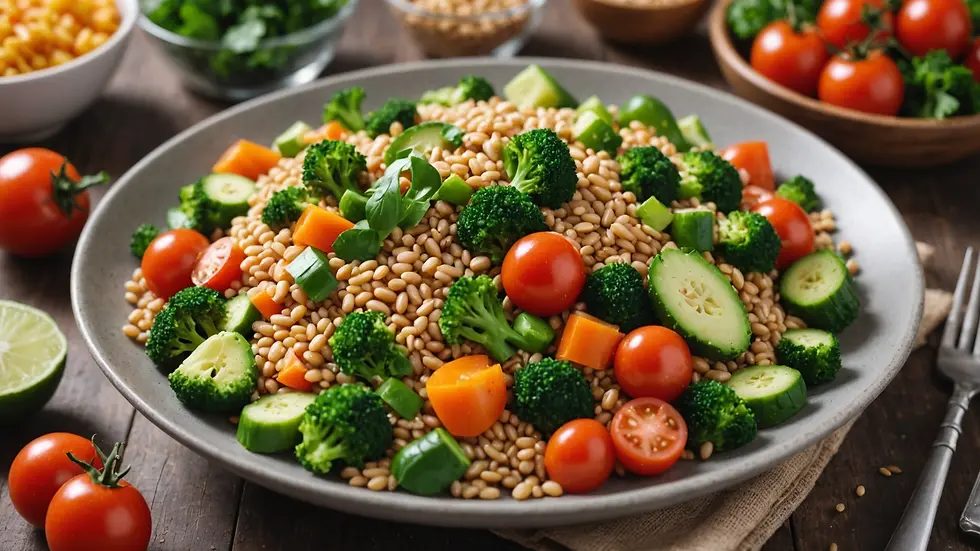Uncovering the Mystery: The Science Behind the Perfect Workout Ratio
- Wambui Nyarko
- Feb 13
- 5 min read
In a world where fitness fads come and go, the quest for the most effective workout regimen is a constant. For many, the mantra "work out harder, not smarter" has become a way of life, often leading to burnout, injuries, and disappointment. However, recent studies and expert opinions suggest an alternative approach: working out smarter, not harder. But how many easy workouts equate to one challenging session? This blog post dives into the science behind the optimal workout ratio, helping you understand how to balance intensity and volume in your fitness journey.
The Fitness Paradigm Shift
Historically, fitness enthusiasts believed that long hours spent grinding at the gym were the only path to success. Whether it was pushing weights to their limits or engaging in exhausting cardio sessions, the prevailing sentiment was that “no pain, no gain” was the rule of thumb.
However, this approach is beginning to shift. Several fitness experts now advocate for high-quality workouts that prioritize efficiency over sheer effort. This new paradigm raises the question: Can a few easy workouts yield the same benefits as one intense session?
Ultimately, the key to a successful fitness plan lies in understanding your individual fitness goals and how the body responds to different intensities and volumes of exercise.
Understanding Workout Intensity and Volume
Before delving into the ratio of easy to challenging workouts, it's essential to define what we mean by "easy" and "challenging" workouts.
Easy Workouts: These typically involve lower intensity and moderate exertion. Examples include walking, light jogging, or yoga. These workouts are generally beginner-friendly and emphasize recovery and joint health.
Challenging Workouts: In contrast, these sessions can consist of high-intensity interval training (HIIT), heavy weightlifting, or endurance training that truly pushes the limits of your personal abilities.
The interaction between workout intensity and volume is crucial. While intensity focuses on how hard you work during the session, volume refers to the total amount of exercise completed, which can include the number of reps, sets, and time spent exercising.
Understanding the relationship between these two variables can help you determine the most effective workout routine for your body.

Why Smarter Workouts Matter
Adopting smarter workout techniques can lead to numerous benefits, including:
Injury Prevention: Lower intensity sessions often lead to reduced strain on muscles and joints, thereby decreasing the risk of injury.
Sustainability: Easy workouts can be maintained consistently over the long haul, preventing burnout and promoting a lifelong commitment to fitness.
Active Recovery: Incorporating easy workouts allows for periods of recovery, which are vital for muscle repair and growth.
Improved Performance: Combining easy and challenging workouts can enhance overall performance by allowing your body to recover adequately between intense training sessions.
Understanding these benefits encourages fitness enthusiasts to consider the potential advantages of utilizing a balanced approach to their training.
The Science of Workout Ratios
While the relationship between easy and challenging workouts can vary from person to person based on fitness levels, goals, and physical capabilities, studies suggest an approximate ratio. A common guideline is to incorporate 2-3 easy workouts for every challenging workout.
For example, if you choose to do one high-intensity workout each week, you might pair it with 2-3 sessions of lighter exercise each week. This could include activities such as:
Light jogging or brisk walking: Great for cardiovascular health without overexertion.
Yoga or Pilates: Beneficial for flexibility and core strength, providing an active yet low-intensity workout.
Swimming: Offers a full-body workout that is easy on the joints, making it an excellent recovery option.

Tailoring Your Workout Strategy
The ideal ratio doesn't have to be one-size-fits-all. Everyone has a unique physiology and varying responses to exercise. The key is in self-awareness and tailoring workouts based on personal needs. Consider the following strategies to determine your optimal workout ratio:
Assess Your Fitness Goals: Are you aiming for weight loss, muscle building, endurance improvement, or general well-being? Understanding your goals will shape your workout structure.
Monitor Your Body’s Feedback: Keep track of how your body reacts after different workouts. If you're feeling excessively fatigued or unmotivated, it might indicate that you're working too hard without sufficient recovery.
Experiment with Ratios: Try different combinations of easy and challenging workouts for a set period, then assess which ratio works best for you based on your physical and mental health.
Account for Lifestyle Factors: External factors such as work, stress levels, and sleep quality can affect your fitness routine. If you're feeling overwhelmed to the point where a high-intensity session feels daunting, consider focusing more on easy workouts during that time.
Balancing Cardio and Strength Training
An effective workout routine should strike a balance between cardiovascular exercises and strength training. Each plays a distinct role in your overall fitness, thus impacting the ratio of easy workouts to challenging ones.
Cardiovascular Exercise: Walking, cycling, and swimming are forms of cardio that can vary in intensity. Low-intensity bouts of cardio promote heart health and allow for adequate recovery.
Strength Training: Incorporating resistance exercises like weightlifting can be highly beneficial, but it's vital to mix high and low-intensity sessions. An example might be a high-intensive strength workout, followed by lighter sessions focusing on bodyweight exercises.
Integrating both types of exercise can empower your fitness plan, preventing plateaus and developing a well-rounded physique.
The Role of Nutrition in Recovery
While workout ratios are significant, nutrition plays a complementary role in overall fitness. Ensuring you’re consuming enough protein, carbohydrates, and fats after workouts - especially after challenging ones - helps recover and rebuild muscle tissue efficiently.
Consider the following:
Protein: Consider incorporating sources such as lean meats, dairy, and legumes to aid muscle repair.
Carbohydrates: Post-workout carb intake can replenish glycogen stores and restore energy levels.
Hydration: Proper hydration is essential to maintaining performance levels and aiding recovery.
Understanding nutrition allows you to amplify the results of your workout strategy, ensuring that your body is supported as you work out smarter, not harder.

Conclusion
The mystery behind finding the perfect workout ratio is progressively being unraveled. By emphasizing the importance of balancing easy and challenging workouts, fitness enthusiasts can work smarter, avoiding unnecessary burnout while still achieving their fitness goals.
Ultimately, taking a personalized approach to your workout routine can lead to sustainable health and wellness. As you navigate your fitness journey, remember to listen to your body, adjust your intensity, and foster a positive relationship with movement. Whether you choose to mix in more easy workouts or ramp up the intensity occasionally, what matters most is consistency, balance, and an understanding of your body's unique needs.
Working out smarter, not harder, is not just a concept; it’s a path that can lead to profound improvements in overall fitness and well-being. So, embark on this journey, knowing that every step you take toward a balanced approach is a step toward a healthier you.



Comments